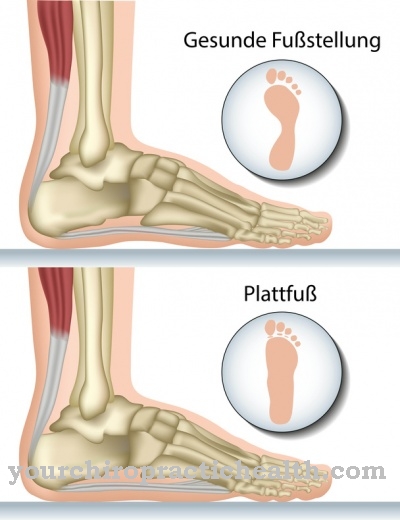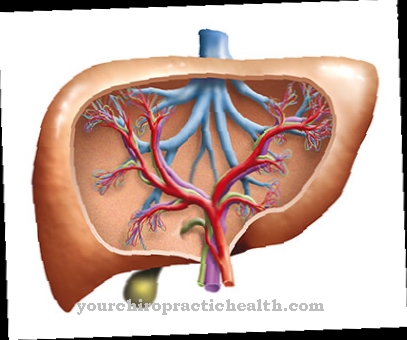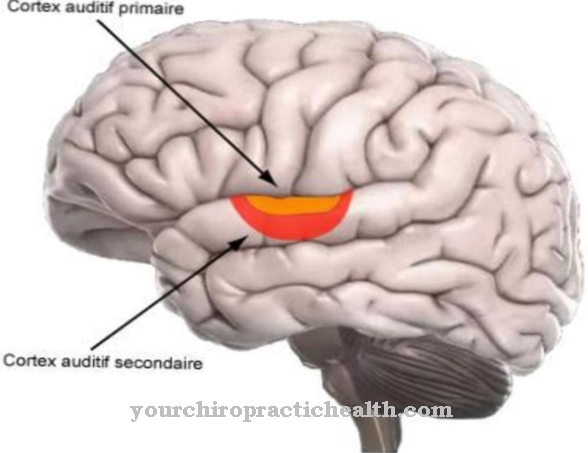A subdural hematoma is a hemorrhage of the brain and usually occurs as a result of head injuries. A distinction is made between acute and chronic subdural hematoma, whereby the symptoms are the same in both cases, but can occur at different rates. Rapid diagnosis is particularly important as life-threatening complications can arise.
What is a subdural hematoma?

© freshidea - stock.adobe.com
Subdural hematomas usually arise due to a head injury and can sometimes be life-threatening. It is a cerebral hemorrhage, which is located in the skullcap on the surface of the brain. A distinction is made between an acute and a chronic form.
An acute subdural hematoma results from a serious head injury, and a chronic one can result from a minor head injury or increased falls. The term is also used for blood clots on the surface of the brain. These can arise as a result of congenital vascular malformations or due to risk factors such as high blood pressure, smoking or obesity.
causes
As soon as there is a rupture between the skull and the brain surface, i.e. the vein bursts, the so-called subdural hematomas develop. In the case of a severe head injury, for example, the space between the brain and the skull may fill with blood. This acute subdural hematoma is among the most dangerous of its kind because it can cause life-threatening symptoms.
Most acute subdural hematomas result from a blow or blow to the head, from falls, or, more commonly, from car accidents. These bruises appear immediately along with the symptoms. Chronic subdural hematomas, on the other hand, develop slowly. The cause is considered to be minor or repetitive head injuries.
It is therefore often the case that older people are affected if they have already fallen several times. The symptoms usually appear later, sometimes even a few weeks in between and are therefore not recognized immediately. Treatment is simpler, although life-threatening complications can occur.
Symptoms, ailments & signs
The symptoms of a subdural hematoma appear immediately in the acute form and delayed or not at all in the chronic form. However, recognizing the symptoms is extremely important in order to be able to receive treatment on time. The most common symptoms are headaches, speech disorders, and cramps. Also visual disturbances, numbness, weakness and Loss of consciousness can be felt as side effects.
Diagnosis & course of disease
In order to diagnose a subdural hematoma, an examination using MRI (magnetic resonance imaging) or CT (computed tomography) is necessary. In addition, a complete blood count can provide information about the number of red and white blood cells, since too low a number of red blood cells indicates excessive blood loss. Sometimes a physical exam may be done, blood pressure and pulse checked as these factors can indicate internal bleeding.
Complications
A subdural hematoma can cause a number of complications and in individual cases also have long-term consequences. Most people who have suffered a traumatic brain injury have increased intracranial pressure. This can lead to coma or death. Furthermore, seizures can occur, which are associated with an increased risk of accidents.
In the case of major injuries, muscle weakness or numbness is also conceivable in certain areas of the body. Typical long-term effects of a subdural hematoma are impaired mental performance and neurological disorders. As a result of trauma, some patients also develop mental illnesses such as anxiety disorders or depression.
Since the surgical treatment of a subdural hematoma is a complicated procedure, it can lead to minor and major complications. Possible risks of a craniotomy are bleeding and bruising, as well as infection and wound healing disorders. Occasionally, blood clots form, which can cause convulsions and possibly death.
Particular risks when opening the skull are injuries to healthy brain tissue, leakage of cerebral fluid and accumulation of air in the skull cavity. The anesthesia can also be associated with incidents. For example, sudden heart failure can occur.
When should you go to the doctor?
After a head injury, it should be carefully examined whether the symptoms are persistent or worsening. A doctor does not always have to be consulted for minor injuries. If symptoms disappear almost completely within a few minutes, there is usually no need for further treatment. However, if you feel sick, dizzy or unsteady, you need to consult a doctor.
Headache, bleeding or damage to the skull should be examined and treated. Regardless of whether the head injury was caused by a fall, impact, accident or violence, there may be damage that, in severe cases, can lead to irreversible damage or to the premature death of the person concerned. A doctor's visit is therefore necessary in the event of speech disorders, general functional disorders or sudden convulsions. A sudden decrease in eyesight is to be understood as an alarm signal from the organism.
Since the symptoms described can occur in some patients without an immediate head injury, a doctor should also be consulted if irregularities occur without a shock or a perceived impact on the head.
Sudden weakness, numbness or sensory disturbances should also be examined as soon as possible. In the event of a disturbance of consciousness or a loss of consciousness, an emergency service must be alerted. In these cases there is a mortal danger, so that the person concerned needs immediate medical attention.
Treatment & Therapy
An acute subdural hematoma can only be treated in a hospital, as the brain can swell at any time. This swelling causes increased internal pressure in the skull, which must be treated with special drill holes in the skull. A craniotomy is performed to remove a large subdural hematoma.
This is a surgical procedure that has to be carried out especially in acute cases. During this procedure, part of the skull is removed and then the blood clot or hematoma is suctioned off and rinsed out. In the case of smaller hematomas, there is the possibility of draining them using drill holes.
This involves inserting thin tubes into the small holes in the skull, allowing the blood to escape from the hematomas. In addition, brain injuries are also treated with medication, since inflammation can be fought with corticosteroids, for example. Treatment or prevention of side effects such as cramps can also be done with appropriate medication.
Nevertheless, complications from subdural hematomas are not uncommon. These can occur even some time after treatment is given. Persistent numbness, muscle weakness, seizures or rising intracranial pressure can occur. The latter is particularly dangerous as it can lead to a coma or death.
The complications can vary in severity depending on the severity of the skull injury. A prognosis also depends on the severity of the injury, the location and extent of the subdural hematoma. The chances are good for chronic subdural hematomas, but the acute form can vary widely. According to the US Department of Neurosurgery ULCA, approximately 50 to 90 percent of cases result in death due to the disease or its complications.
prevention
Due to congenital vascular malformations, bleeding in the brain can occur at any time; prevention is not possible in this case. However, high blood pressure is also considered to be a huge risk of bleeding in the brain and can be treated accordingly. Regular medical check-ups are therefore essential if you have already diagnosed high blood pressure.
Smoking also increases the risk of cerebral haemorrhage by two or three times. The same applies to regular, high alcohol consumption, being very overweight and high cholesterol levels. Therefore preventative measures can be taken to reduce the risk of bleeding in the brain. Scheduled visits to the doctor, a healthy diet and sufficient exercise can go a long way before problems arise.
Aftercare
Since the disease can quickly lead to thought disorders and many other complaints, those affected should avoid any stressful situations. The body should be spared enough so that these complaints can be prevented. Since the disease is usually associated with a head injury, the injury should be adequately cooled by those affected.
Cold packs and poultices are very helpful in relieving discomfort and treating swelling. If the disease has already triggered numerous complaints, those affected have to undergo physiotherapy. The cerebral haemorrhage caused by the disease can cause severe and permanent consequential damage.
People who have the condition should seek out a support group. It can be very helpful to talk to other people about the disease. This also has the effect that those affected do not feel alone and are made familiar with methods and practices that show them how they can lead a largely normal life with the disease.
After the cerebral haemorrhage, a change in the personality of those affected can occur as a consequence. It is very important that people with the disease see a psychologist. In addition, relatives should be sufficiently informed about the illness so that emergency action can be taken immediately. Help and support from family members is imperative.
You can do that yourself
After a subdural hematoma, thought disorders and other neurological complaints can still occur for some time. The most important self-help measure is to avoid stress and to go easy on the body.
Since a subdural hematoma usually occurs in connection with severe head injuries, the head must always be cooled. Cooling compresses, as well as curds made from quark or medicinal ointments are ideal to relieve any swelling and pain. If the subdural hematoma has caused long-term discomfort, comprehensive physiotherapy is necessary.With severe cerebral hemorrhage, permanent disorders can remain. People who have had a subdural hematoma benefit from talking to other sufferers. The doctor can establish contact with a self-help group and, if necessary, call in other specialists and medical professionals. After severe cerebral haemorrhage, personality changes may also occur.
It is the responsibility of the relatives to support the person concerned as much as possible. In addition, regular visits to the doctor must always be ensured. In the first few months after a cerebral haemorrhage, brain scans must be taken regularly. If no abnormalities are found, no other measures need to be taken apart from the typical therapeutic measures.



.jpg)












.jpg)







.jpg)



